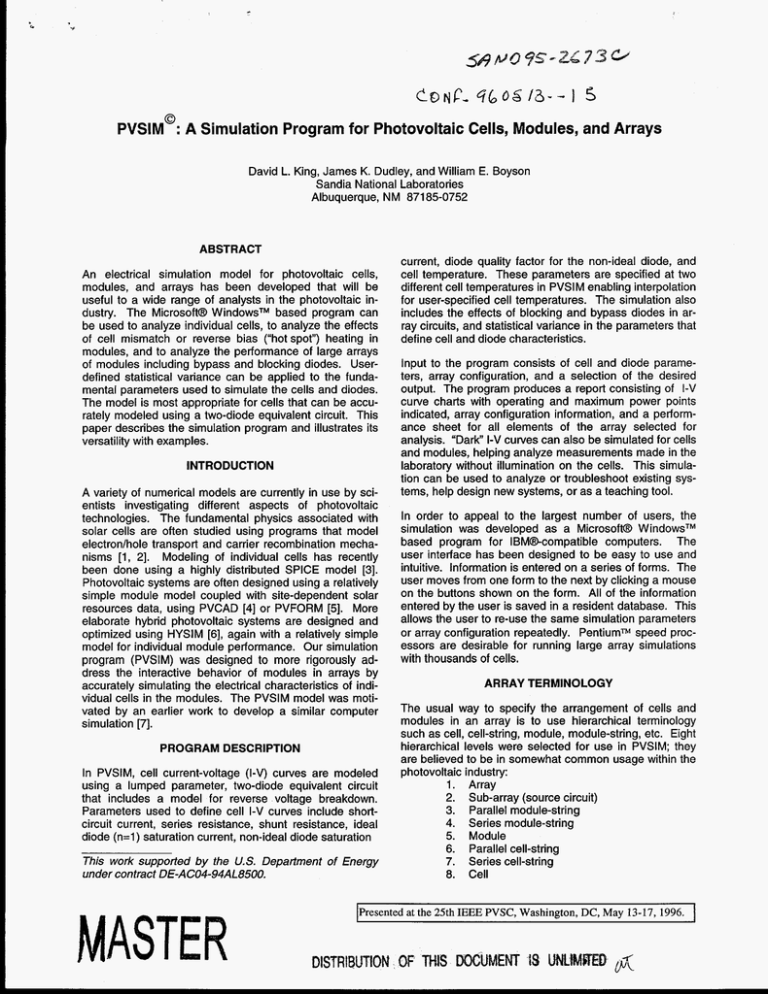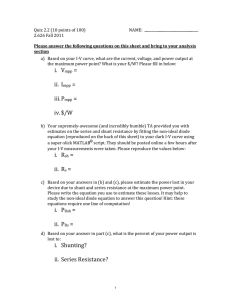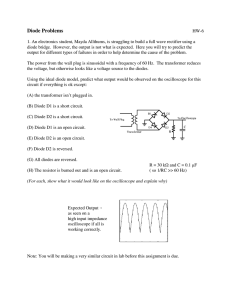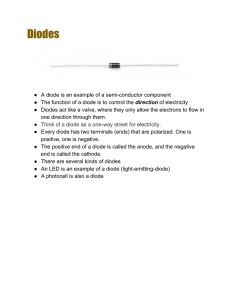A simulation program for photovoltaic cells
advertisement

h PVSIMw: A Simulation Program for Photovoltaic Cells, Modules, and Arrays David L. King, James K. Dudley, and William E. Boyson Sandia National Laboratories Albuquerque, NM 87185-0752 ABSTRACT An electrical simulation model for photovoltaic cells, modules, and arrays has been developed that will be useful to a wide range of analysts in the photovoltaic industry. The Microsoft@ WindowsTMbased program can be used to analyze individual cells, to analyze the effects of cell mismatch or reverse bias (“hot spot”) heating in modules, and to analyze the performance of large arrays of modules including bypass and blocking diodes. Userdefined statistical variance can be applied to the fundamental parameters used to simulate the cells and diodes. The model is most appropriate for cells that can be accurately modeled using a two-diode equivalent circuit. This paper describes the simulation program and illustrates its versatility with examples. INTRODUCTION A variety of numerical models are currently in use by scientists investigating different aspects of photovoltaic technologies. The fundamental physics associated with solar cells are often studied using programs that model electron/hole transport and carrier recombination mechanisms [l,21. Modeling of individual cells has recently been done using a highly distributed SPICE model [3]. Photovoltaic systems are often designed using a relatively simple module model coupled with site-dependent solar resources data, using PVCAD [4]or PVFORM [5]. More elaborate hybrid photovoltaic systems are designed and optimized using HYSIM [6],again with a relatively simple model for individual module performance. Our simulation program (PVSIM) was designed to more rigorously address the interactive behavior of modules in arrays by accurately simulating the electrical characteristics of individual cells in the modules. The PVSIM model was motivated by an earlier work to develop a similar computer simulation [7]. PROGRAM DESCRIPTION In PVSIM, cell current-voltage (I-V) curves are modeled using a lumped parameter, two-diode equivalent circuit that includes a model for reverse voltage breakdown. Parameters used to define cell I-V curves include shortcircuit current, series resistance, shunt resistance, ideal diode (n=l) saturation current, non-ideal diode saturation This work supported by the U S . Department of Energy under contract DE-AC04-94AL8500. current, diode quality factor for the non-ideal diode, and cell temperature. These parameters are specified at two different cell temperatures in PVSIM enabling interpolation for user-specified cell temperatures. The simulation also includes the effects of blocking and bypass diodes in array circuits, and statistical variance in the parameters that define cell and diode characteristics. Input to the program consists of cell and diode parameters, array configuration, and a selection of the desired output. The program produces a report consisting of I-V curve charts with operating and maximum power points indicated, array configuration information, and a performance sheet for all elements of the array selected for analysis. “Dark” I-V curves can also be simulated for cells and modules, helping analyze measurements made in the laboratory without illumination on the cells. This simulation can be used to analyze or troubleshoot existing systems, help design new systems, or as a teaching tool. In order to appeal to the largest number of users, the simulation was developed as a Microsoft@ WindowsTM based program for IBWcompatible computers. The user interface has been designed to be easy to use and intuitive. Information is entered on a series of forms. The user moves from one form to the next by clicking a mouse on the buttons shown on the form. All of the information entered by the user is saved in a resident database. This allows the user to re-use the same simulation parameters or array configuration repeatedly. Pentiumm speed processors are desirable for running large array simulations with thousands of cells. ARRAY TERMINOLOGY The usual way to specify the arrangement of cells and modules in an array is to use hierarchical terminology such as cell, cell-string, module, module-string, etc. Eight hierarchical levels were selected for use in PVSIM; they are believed to be in somewhat common usage within the photovoltaic industry: 1. Array 2. Sub-array (source circuit) 3. Parallel module-string 4. Series module-string 5. Module 6. Parallel cell-string 7 . Series cell-string 8. Cell Presented at the 25th IEEE PVSC, Washington, DC, May 13-17, 1996. DISTRtBUT1QN OF THIS ~~~~~ 18 ~~~~ CELL SIMULATION MODEL The PVSlM model starts with fundamental cell characteristics for each cell in an array. The lumped-parameter, two-diode equivalent circuit used for each cell is defined by Equations 1-5. This two-diode circuit works well for a wide variety of solar cell technologies and temperatures. The model includes parameters for an ideal diode (n=l) and a non-ideal (n#l) diode, shunt and series resistance, short-circuit current, reverse breakdown parameters, as well as cell temperature. Photon generated current is calculated using Eq. 1 given the cell parameters and the short-circuit current (Isc). I = Ip - Id1 - 162 - Ish (11 where: I = Cell current (A) Ip = Photon generated current (A) Id1 = Ideal diode current (A) Id2 = Non-ideal diode current (A) Ish = Shunt current (A) The currents are calculated from the following equations: Vi = V + IR, where: I = Cell current (A) V = Cell voltage (V) Rs= Series resistance (a) Rsh = Shunt resistance (a) q = Elementary charge = 1.602177E-19 (C) k = Boltzmann’s constant = 1.380662E-23 (JK) T = Junction temperature (K) Vj = Calculated junction voltage (V) lOl= Ideal diode recombination current (A) 102 = Non-ideal diode recombination current (A) Vbr = Junction breakdown voltage (V) n2 = Non-ideal diode quality factor a = Fraction of shunt current involved in breakdown m = Avalanche breakdown exponent Parameters for each cell in an array are generated statistically so that cell-to-cell variance is included; the user specifies the standard deviation for each parameter. As an option, the user may specify cell parameters exactly. Individual cells may also be open-circuited or shortcircuited, or have their parameters altered independent of other cells as desired. These provisions make it possible to analyze the effects of cell or module mismatch on array performance, and to analyze the influence of component failures. Another advantage of the simulation is that temperature coefficients for current and voltage are implicitly contained in the fundamental cell parameters. Translating from one irradiance and temperature condition to another does not require the coefficients used in standard ASTM methods [8]. Bypass and blocking diodes can both be included in the simulation of an array. A lumped-parameter single-diode equivalent circuit with shunt and series resistance is used to simulate the diodes. Parameters are also included to simulate diode reverse breakdown and temperature effects. The diode model is similar to the cell model except that there is no photon generated current and only one diode current. Parameters for each diode in the array can be generated statistically or specified exactly. Diodes may also be open-circuited or short-circuited. PARAMETER DETERMINATION The photovoltaic literature has contained papers describing techniques for extracting one or more of the parameters used in the solar cell equivalent circuit previously discussed for over thirty years [9, IO]. The use of the twodiode equivalent circuit provides a better match to solar cell performance over a wider range of operating conditions than a single-diode circuit. However, the process for determining “physically meaningful” cell parameters that fit measured I-V data over a wide range of operating conditions becomes more problematic. The method preferred by the authors uses nonlinear regression analysis of dark I-V measurements at cell temperatures of 25 “C and 75 “C to obtain two sets of values for lOl, 102, n2, Rs, and Rsh [ l l ] . The values for Isc are determined using conventional illuminated I-V measurements at the same temperatures. Interpolation is then used in PVSlM to find appropriate values for the parameters at temperatures between these two extremes. By determining parameters for a production sample of cells, parameters as well as an estimate of their production variance can be determined. EXAMPLES PVSlM provides a variety of analytical results from the simulation. The first is a chart of I-V curves as pictured in Fig. 1. The chart shows the user selected I-V curves with each one drawn in a different color and individually labeled. Maximum power points are shown as small diamonds and operating points are shown as small circles. The case illustrated is a 36-cell crystalline silicon module with bypass diodes around every twelve cells, and with one substandard cell producing about 10 percent less current than the others. The second example, Fig. 2, illustrates the diagnostic capability of PVSlM for an old 2-kW array (1920 cells) with wiring problems. The array is composed of four large modules (panels) connected in series. Each module is composed of 30 parallel cell-strings, each cell-string with 12 cells in series. For the simulation, three cell-strings . were open circuited in one module, six cell-strings in a second module, and nine in the third module. In addition to I-V curve charts, the user may print a report which includes array performance parameters and setup information. Performance information includes the maximum power point, operating point, short circuit current, open circuit voltage, fill factor, and operating state for each I-V curve selected in the initial setup. Bypass and blocking diode operating conditions are also given indicating whether they are conducting normally or dissipating energy. CONCLUSIONS A Microsoft@WindowsTMprogram has been developed for simulating the electrical performance of cells, modules, and arrays. A beta-version of the software has been distributed to about twenty potential users. continued development of the program with the intent of more general distribution will depend on the level of interest shown by the photovoltaic community. Please forward inquiries regarding software availability to the following address. David L. King Sandia National Laboratories Dept. 6219 MS-0752 Albuquerque, NM 87185-0752 USA Fax: 505-284-3239 email: dlkingQsandia.gov ACKNOWLEDGMENTS The authors would like to acknowledge useful discussions with James Bishop (ESTI) whose earlier work on a simulation model (PVNeT) helped motivate this work. Thanks also to Paul Basore, Kent Schubert, and James Gee for their technical assistance. REFERENCES 1. Fig. 1. 36-cell c-Si module with three bypass diodes and one weak cell. Fig. 2. Old 2-kW c-Si array with bypass diodes and several open-circuited cell-strings. P.A. Basore, “PC-1D Version 3: Improved Speed and Convergence,” 2PdIEEE PVSC, 299-302 (1991). 2. J. Gray, “ADEPT: General Purpose Device Simulator for Modeling Solar Cells in One-, Two-, and ThreeDimensions.” 22nd IEEE PVSC, pp. 436-438,1991. 3. A. Zekry and A. AI-Mazroo, “A Distributed SPICEModel of a Solar Cell,” /€€€ Transactions on Electron Devices, Vol. 43, No. 5, May 1996. 4. B. Kazeta, PVCAD, Photovoltaic Resources International, 1440 W. Meseto, AZ, 85202. 5. D. Menicucci and J. Fernandez, “User’s Manual for PVFORM: A Photovoltaic System Simulation Program for Stand-Alone and Grid-Interactive Applications,” Sandia National Laboratories Report, SAND85-0376,1988. 6. R. Chapman and G. Jones, “PhotovoltaidDiesel Hybrid Systems: The Design Process,” 19th I€€.€ PVSC, pp. 1024-1030, 1987. 7. J. Bishop, Computer Simulation of the Effects of Electrical Mismatches in Photovoltaic Cell Interconnection Circuits, Solar Cells, 25, 1988, p. 73-89. 8. ASTM E-1036, “Standard Methods for Testing Electrical Performance of Nonconcentrator Terrestrial PV Modules and Arrays Using Reference Cell.” 9. R.J. Handy, ‘Theoretical Analysis of the Series Resistance of a Solar Cell,” Solid State Electronics, Vol. IO, p. 765, 1967. IO. A. Aberle, S. Wenham, and M. Green, “A New Method for Accurate Measurements of the Lumped Series Resistance of Solar Cells,” 23th I€€€ PVSC, pp 133-139, 1993. 11. FitAll: Nonlinear Regression Analysis, MTR Software, PO Box 902, Station P, Toronto, Canada, M5S2Z2. This report was prepared as an account of work sponsored by an agency of the United States Government. Neither the United States Government nor any agency thereof, nor any of their employees, makes any warranty, express or implied, or assumes any legal liability or responsibility for the accuracy, completeness, or usefulness of any information, apparatus, product, or process disclosed, or represents that its use would not infringe privately owned rights. Reference herein to any specific commercial product, process, or service by trade name, trademark, manufacturer, or otherwise does not necessarily constitute or imply its endorsement, recommendation, or favoring by the United States Government or any agency thereof. The views and opinions of authors expressed herein do not necessarily state or reflect those of the United States Government or any agency thereof.




